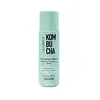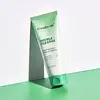What's inside
What's inside
 Key Ingredients
Key Ingredients

 Benefits
Benefits

 Concerns
Concerns

 Ingredients Side-by-side
Ingredients Side-by-side

Water
Skin ConditioningDecyl Glucoside
CleansingSodium Cocoyl Isethionate
CleansingCocamidopropyl Betaine
CleansingCaprylyl/Capryl Glucoside
CleansingGlycerin
HumectantPEG-120 Methyl Glucose Dioleate
EmulsifyingPhenoxyethanol
PreservativeSodium Chloride
MaskingCoconut Acid
CleansingSodium Isethionate
CleansingCitric Acid
BufferingSaccharomyces/Xylinum/Black Tea Ferment
Skin ConditioningEthylhexylglycerin
Skin ConditioningPolyquaternium-10
Ceramide Ng
Skin ConditioningGlyceryl Oleate
EmollientCichorium Intybus Root Extract
MaskingPentylene Glycol
Skin ConditioningSodium Hyaluronate
HumectantWater, Decyl Glucoside, Sodium Cocoyl Isethionate, Cocamidopropyl Betaine, Caprylyl/Capryl Glucoside, Glycerin, PEG-120 Methyl Glucose Dioleate, Phenoxyethanol, Sodium Chloride, Coconut Acid, Sodium Isethionate, Citric Acid, Saccharomyces/Xylinum/Black Tea Ferment, Ethylhexylglycerin, Polyquaternium-10, Ceramide Ng, Glyceryl Oleate, Cichorium Intybus Root Extract, Pentylene Glycol, Sodium Hyaluronate
Water
Skin ConditioningGlycerin
HumectantPalmitic Acid
EmollientLauric Acid
CleansingStearic Acid
CleansingMyristic Acid
CleansingPotassium Hydroxide
BufferingCocamidopropyl Betaine
CleansingPEG-100 Stearate
Glyceryl Stearate
EmollientBeeswax
Emulsion StabilisingGlycol
HumectantEthylhexylglycerin
Skin ConditioningPolyquaternium-10
Capric Acid
CleansingDisodium EDTA
Aloe Barbadensis Leaf Extract
EmollientOryza Sativa Extract
AbsorbentCamellia Sinensis Leaf Extract
Antimicrobial1,2-Hexanediol
Skin ConditioningHydrogenated Lecithin
EmulsifyingPolyglyceryl-10 Stearate
Skin ConditioningLilium Tigrinum Root Extract
HumectantPanthenol
Skin ConditioningSodium Hyaluronate
HumectantSodium Ascorbyl Phosphate
AntioxidantHydroxypropyltrimonium Hyaluronate
Niacinamide
SmoothingHydrolyzed Hyaluronic Acid
HumectantPyridoxine
Skin ConditioningFolic Acid
Skin ConditioningSodium Acetylated Hyaluronate
HumectantBiotin
AntiseborrhoeicHyaluronic Acid
HumectantHydrolyzed Sodium Hyaluronate
Skin ConditioningTocopherol
AntioxidantSodium Hyaluronate Crosspolymer
HumectantCyanocobalamin
Skin ConditioningPotassium Hyaluronate
Skin ConditioningThiamine Hcl
MaskingBeta-Carotene
Skin ConditioningRiboflavin
Cosmetic ColorantLinoleic Acid
CleansingParfum
MaskingWater, Glycerin, Palmitic Acid, Lauric Acid, Stearic Acid, Myristic Acid, Potassium Hydroxide, Cocamidopropyl Betaine, PEG-100 Stearate, Glyceryl Stearate, Beeswax, Glycol, Ethylhexylglycerin, Polyquaternium-10, Capric Acid, Disodium EDTA, Aloe Barbadensis Leaf Extract, Oryza Sativa Extract, Camellia Sinensis Leaf Extract, 1,2-Hexanediol, Hydrogenated Lecithin, Polyglyceryl-10 Stearate, Lilium Tigrinum Root Extract, Panthenol, Sodium Hyaluronate, Sodium Ascorbyl Phosphate, Hydroxypropyltrimonium Hyaluronate, Niacinamide, Hydrolyzed Hyaluronic Acid, Pyridoxine, Folic Acid, Sodium Acetylated Hyaluronate, Biotin, Hyaluronic Acid, Hydrolyzed Sodium Hyaluronate, Tocopherol, Sodium Hyaluronate Crosspolymer, Cyanocobalamin, Potassium Hyaluronate, Thiamine Hcl, Beta-Carotene, Riboflavin, Linoleic Acid, Parfum
Ingredients Explained
These ingredients are found in both products.
Ingredients higher up in an ingredient list are typically present in a larger amount.
Cocamidopropyl Betaine is a fatty acid created by mixing similar compounds in coconut oil and dimethylaminopropylamine, a compound with two amino groups.
This ingredient is a surfactant and cleanser. It helps gather the dirt, pollutants, and other impurities in your skin to be washed away. It also helps thicken a product and make the texture more creamy.
Being created from coconut oil means Cocamidopropyl Betaine is hydrating for the skin.
While Cocamidopropyl Betaine was believed to be an allergen, a study from 2012 disproved this. It found two compounds in unpure Cocamidopropyl Betaine to be the irritants: aminoamide and 3-dimethylaminopropylamine. High-grade and pure Cocamidopropyl Betaine did not induce allergic reactions during this study.
Learn more about Cocamidopropyl BetaineEthylhexylglycerin (we can't pronounce this either) is commonly used as a preservative and skin softener. It is derived from glyceryl.
You might see Ethylhexylglycerin often paired with other preservatives such as phenoxyethanol. Ethylhexylglycerin has been found to increase the effectiveness of these other preservatives.
Glycerin is already naturally found in your skin. It helps moisturize and protect your skin.
A study from 2016 found glycerin to be more effective as a humectant than AHAs and hyaluronic acid.
As a humectant, it helps the skin stay hydrated by pulling moisture to your skin. The low molecular weight of glycerin allows it to pull moisture into the deeper layers of your skin.
Hydrated skin improves your skin barrier; Your skin barrier helps protect against irritants and bacteria.
Glycerin has also been found to have antimicrobial and antiviral properties. Due to these properties, glycerin is often used in wound and burn treatments.
In cosmetics, glycerin is usually derived from plants such as soybean or palm. However, it can also be sourced from animals, such as tallow or animal fat.
This ingredient is organic, colorless, odorless, and non-toxic.
Glycerin is the name for this ingredient in American English. British English uses Glycerol/Glycerine.
Learn more about GlycerinPolyquaternium-10 is an ammonium salt of hydroxyethylcellulose. It is a white and granular powder used as a film-former and anti-static agent.
This ingredient is commonly found in hair conditioning products. According to a manufacturer, its positive charge makes it great for absorbing hair proteins. The manufacturer also states this ingredient helps with curl retention.
For haircare friends: this ingredient is not a silicone.
Learn more about Polyquaternium-10Sodium Hyaluronate is hyaluronic acid's salt form. It is commonly derived from the sodium salt of hyaluronic acid.
Like hyaluronic acid, it is great at holding water and acts as a humectant. This makes it a great skin hydrating ingredient.
Sodium Hyaluronate is naturally occurring in our bodies and is mostly found in eye fluid and joints.
These are some other common types of Hyaluronic Acid:
Learn more about Sodium HyaluronateWater. It's the most common cosmetic ingredient of all. You'll usually see it at the top of ingredient lists, meaning that it makes up the largest part of the product.
So why is it so popular? Water most often acts as a solvent - this means that it helps dissolve other ingredients into the formulation.
You'll also recognize water as that liquid we all need to stay alive. If you see this, drink a glass of water. Stay hydrated!
Learn more about Water